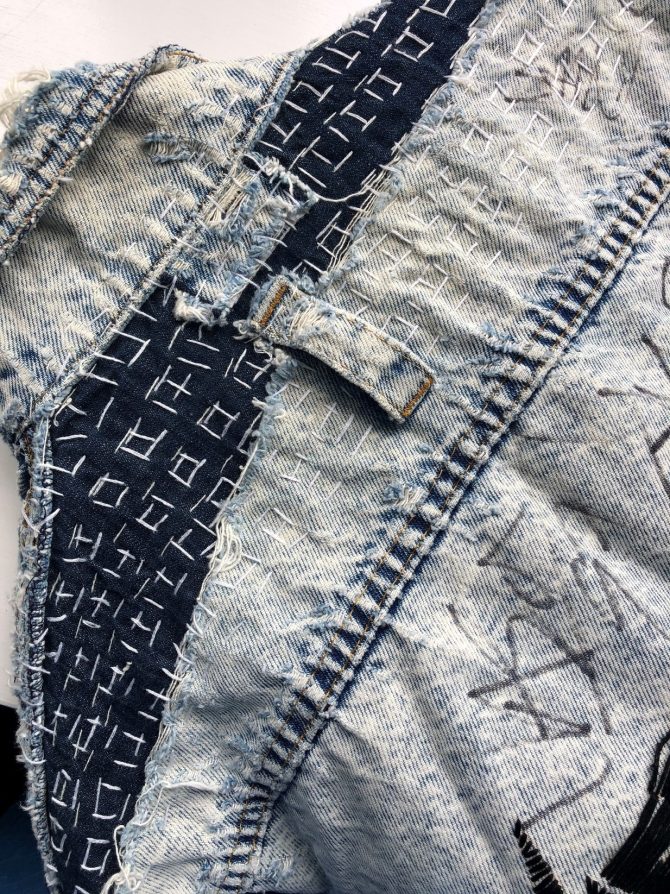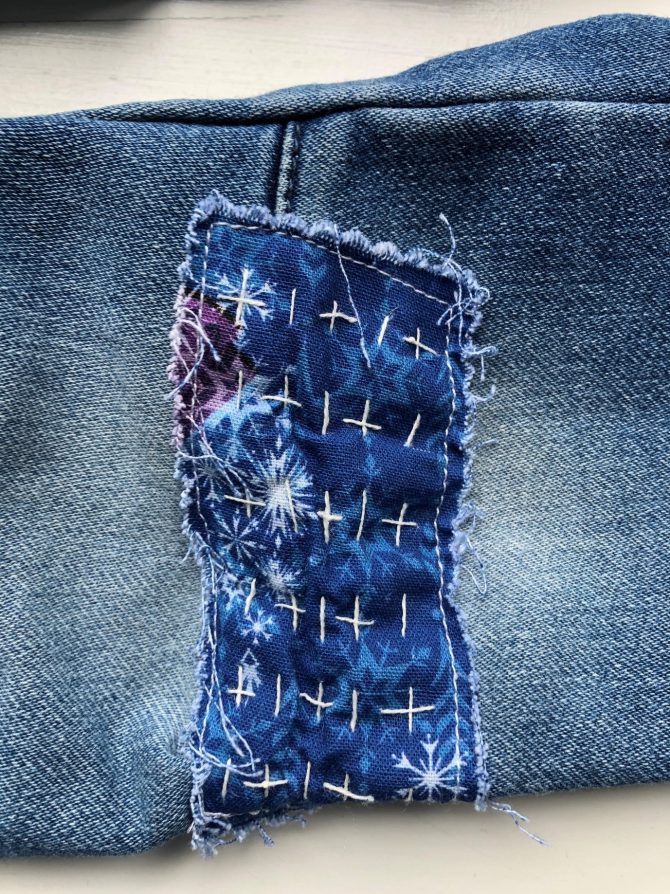Sally reports back from the last Craft Snippets event at Upper Riccarton Library. The next event on Wednesday 26 May features guest Ira Mitchell-Kirk, an artist whose work is bold, bright and uplifting. The landscapes of New Zealand are her inspiration in a reduced geometric form.
Sustainable fashion choices
Creative maker, Amy Hewgill talked about what that means, using bits and bobs you already have and jazzing them up, mending items over and over and wearing everything that is mended, upcycled or bought from an op-shop. There is no buying new.
This adventure for Amy started in 2005 when she was living in Canada and taught herself how to knit. From this Amy became a creator of things and created her own unique style. Amy went to sewing school for a year and loved it, learning all the basic foundation skills. The more she learned the more she wanted to know. Amy hates to shop and like so many of us finds clothing doesn’t always fit, we are not one uniform size. Adding to this Amy’s concern for the environment, clothing and fabric is one of the world’s worst pollutants. Also, some clothing industries pay people less than the minimum wage. Amy turned to mending and op-shopping so that she was buying sustainably and items would last longer, in her words ‘last forever’ with lots of emphasis on the “forever”.
There are fantastic books available in the library about mending and below are a couple of Amy’s favourites, “Modern Mending” and “Mending Matters”.
Many ways to mend
There are many different styles of mending.
- Patching – Amy has two small daughters and they are forever going through their trouser knees so she finds patching knees a great way to mend items. It is important to consider the fabric and mend like for like. If you are mending jeans, use jean fabric, if it is stretchy, use stretchy. That way the item will last longer.
- Sashiko is a Japanese style of mending that is very uniform and gorgeous. The idea is that you can see the mending and it becomes beautiful in its own right. Amy showed some examples of mending using Sashiko. One of the ladies mentioned that the Canterbury WEA are running a course on Sashiko. Amy showed a 25 year old denim jacket that has huge sentimental attachment mended using Sashiko. There are wonderful examples of Sashiko on Pinterest and Amy recommends falling down that rabbit hole, if you haven’t already, but warns you may get lost for quite some time. (Below are two pictures of Amy’s mending using Sashiko).
- Darning socks and sweaters is another very old but very useful mending technique. Amy showed an old jersey of her husbands she has mended the elbows of by darning.
- Wool roving is a technique from the Modern Mending book, in fact it is on the cover. Amy is going to try this with her husband’s jersey. This technique involves felting the wool in a circle as you mend, straight on to the jersey. It uses a very special needle with barbs so be careful.
- Dyeing – Amy doesn’t do a lot of dyeing but has found it useful if something has become faded or sun damaged.
- Iron on patches – this is something Amy has done with the silk top she was wearing that had sun damage. It was decorated with a fun criss cross of patches hiding the sun damage. Amy used an iron on product called seamosteam. It was a little trial and error and one of the patches came off while Amy was showing us, but that is all part of the process, experimenting with what works and what doesn’t.


Amy showed an unexpected mend she had done - her camping table. It broke while camping with her girls and she had taken it back to the shop. The shop person asked her why she didn’t try fixing it. “I mend” she said, “not fix”. But that got her thinking and yes she did fix it with buttons and red elastic using a darning needle she had never had cause to use before. Finally a reason to have kept that especially big needle.
Amy talked about the importance of being innovative in how we look at clothes and problem solve, asking ourselves how can we make an item last longer.
Mending questions answered
Somebody asked where to find items for mending - Amy finds the Library’s Great Stash Swap a wonderful place to pick up bits and bobs. Though she told us she has been on a ‘yarn and fabric diet’ trying to use up her already very large stash. Op shops are another place to find treasures good for mending, and garage sales. Creative Junk is another place, and Amy showed a neat Japanese style folded bag she had made with a leather handle found at Creative Junk. Tom’s Emporium is another place to source mending materials.
Amy recommended the Brighton Stitch’o’Mat as a great place to check out. This is a community based sewing room based at the old school in Brighton and offers people a place to upskill their sewing skills with tutors on hand to help.
Somebody talked about the idea of keeping sentimental clothing items and turning them in to a quilt. Another person had heard about someone who had a special pair of trousers they had mended and mended and then put on the wall as a piece of art.
“Do you mend socks?” asked someone, “Yes” was the answer but with great difficulty. It annoys Amy that you go to the effort of knitting socks and then holes appear. Amy uses a darning mushroom but suggests you use oranges or mandarins, and then eat it once you are done.
Someone asked about mending a jersey that had frayed cuffs, would you undo and reknit. Amy suggested you could do that, or you could cut the ends off pick up the stitches and reknit, or cut the ends off and sew on some fabric to finish it off. This would shorten the sleeves.
Someone said that she had a favourite woollen camisole that was moth eaten and had mended it by using embroidery thread and making eyelets around the holes.
Amy talked about mending the inside of trousers and trying different styles of mending to see what worked best. Jeans are not as durable as they used to be due to the increase of elastic in them so that they stretch. Amy said she did make a rug out of jeans strips once.
Someone commented on Amy’s skirt which had two panels sewn into either side. Amy said she loved the skirt, but it no longer loved her. She added the panels and undid the hem to make a funky frayed finish along the hemline.
Amy talked about making tote bags and the Boomerang Bag project, a global initiative that started in Australia. Amy ran a small group here in Christchurch but now with plastic bags not at supermarkets, people have become much better at keeping bags and there has not been the need to be making and handing out bags to people.
The cardigan Amy was wearing was cheap at an op shop and still had the tags on it. It had a cut in it and the shop had not been able to sell it. With a quick mend it was fine. Amy is still thinking about ways she might “pretty up” the mend with embroidery, ribbons and beads that highlight the mend.
There are many ideas for mending and the sky is the limit. Amy told us to experiment and play to our strengths.
As usual Angela took us through some of the newest craft titles that have been added to the library's collection.
View Full List
What’s On
Upcoming craft events
At the library
- Nerdy crafting at Shirley Library on Saturday 15 May
- Next Craft snippets at Upper Riccarton Library, Wednesday 26 May
- Next Great Library Stash Swap is at Tūranga on Sunday 13 June.
- CINCH Community Information Christchurch Check out all the wonderful handicraft groups listed in CINCH Handicraft - CINCH
Other events
- Canterbury WEA have a number of course and activities available. For a great place to keep up with what is happening there, check out their Facebook page, WEA Canterbury Workers' Educational Association | Facebook
- Selwyn Library at times has sewing and crafting courses.
- Knit around the Tram for WWKIP – World Wide Knit in Public Day – Saturday 12 June. Check out the facebook event. We will be knitting and crocheting on the first tram of the day at 10am. Watch out for the knitted tram.
- Outlaw Yarn Pizza & Fibre Craft Nights – every Wednesday evening 6pm onwards. Fibre Craft Community Group – every Thursday morning 10am onwards.
- Creative Junk Sip & Craft on Wednesday nights and Craft mornings on Wednesdays
- The Craft Room, Trafford Street, Craft workshops including candle making, soap making, and rag quilting.
- Hands Ashford, Normans Road, Christchurch Craft workshops including doll making, mosaic classes, beeswax food wrap classes and more.






Add a comment to: Craft Snippets: Sustainable crafting and mending